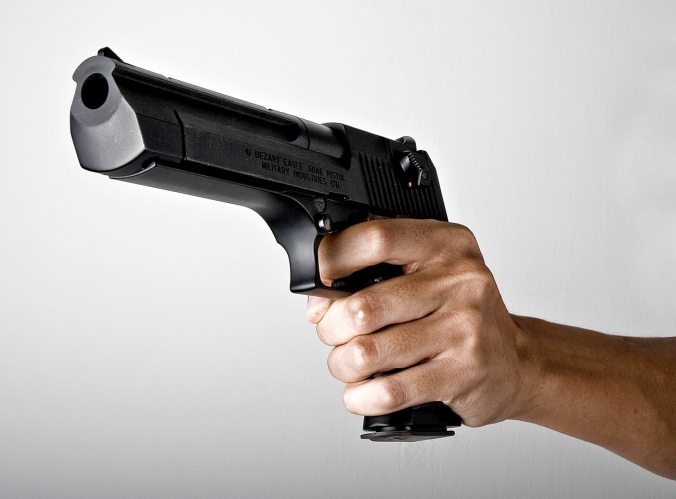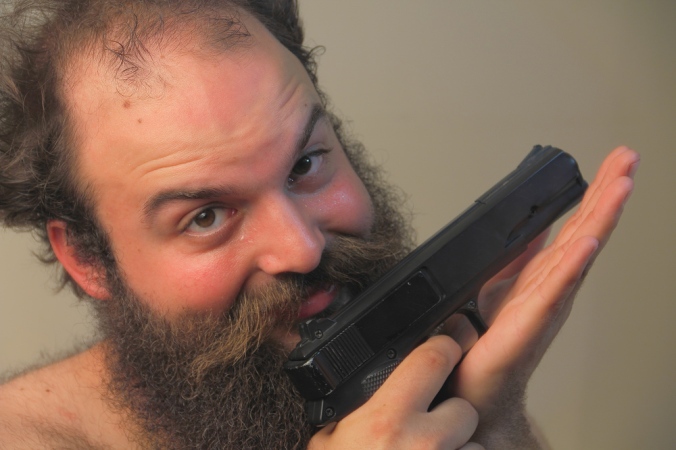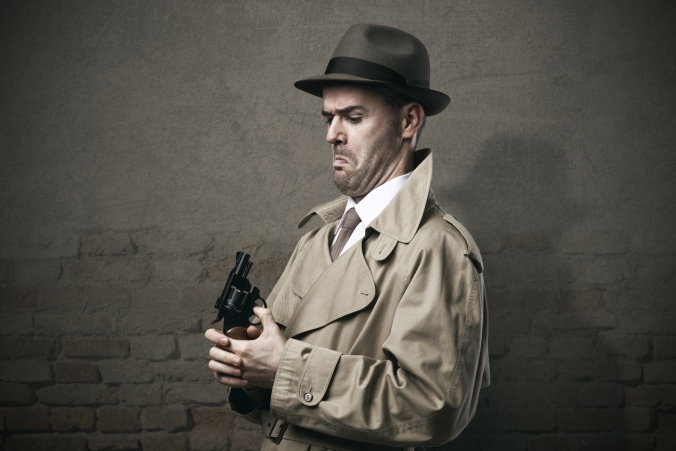Stay Off My Lawn?
Despite how I might come across on this blog and in my book, The Writer’s Guide to Weapons: A Practical Reference for Using Firearms and Knives in Fiction, I am not the guy with the shotgun growling at pedestrians to “stay off my lawn.” I’m also not interested in calling out other writers for their mistakes. As explained in this post, it’s not the point of what I’m trying to do. So maybe it’s not too surprising that I take a softer view about a common (to me) gripe about covers of novels, that of fingers being on triggers.
In keeping with my rule about not cutting down other writers, I won’t post any example covers here. But you’ve probably seen what I’m talking about. There’s a character or disembodied hand with a finger on the trigger of a gun, sort of like this:

This is what a .50 caliber Desert Eagle pistol looks like, by the way. That’s not something I’d want to fire with one hand. It’s a true hand cannon. Better check your dental insurance before pulling the trigger on this mule. (Image by neosiam via sxc.hu)
Sometimes that gun is pointed in an unsafe way for the sake of dramatic art. That might include bursting through a door, managing some difficult terrain, running through obstacles, peeking around a corner, balancing a McMuffin on a steering wheel in traffic, etc. (OK, I haven’t seen that last one, but you get my point.) The gun is typically aimed at another character, a nearby object or the gun-wielder’s own foot, none of which are (presumably) the intended target.
That flies in the face of the old gun safety rule, “finger off the trigger unless prepared to fire.” And that’s where the gun gripes, rightfully, come in from people who know better.
Stock Photo Sites: Home of the Gun Safety Violation
More than likely, the cover art came from one of the major stock image sites, such as Shutterstock or iStock, which are notorious for bad or just plain stupid gun and knife depictions. See my Writer’s Digest article for a great example of a knife gone wrong. Bad art equals bad covers.
But maybe, just maybe, those cover designers boiling in gun sins know something I don’t. It’s not about the steak. It’s about the sizzle.
You’re Always Welcome on My Lawn
Here’s where I part ways with the firearm purist streak I’d otherwise oblige.
A cover is meant to sell the book. It needs to convey a message within the space of a glance. If that message needs to convey “action,” “shootouts,” “suspense,” “cops and robbers,” “thriller,” “mystery” or some such, then I say some wiggle room is appropriate.
“Some” meaning little sins, like fingers on triggers, but not egregious ones, like, oh, sticking an AK-47 into General Robert E. Lee’s hands (although that was actually a cover of an alternative history novel).
Wait, Aren’t You the Guy Who Preaches Accuracy?
So why don’t I give the same breaks to copy that I do to artwork?
To tell you the truth, I’m no hard ass about copy, either, contrary to how someone who wrote this book might come across. I think examining how firearms and knives are depicted in fiction is interesting, but I don’t require what I’m reading to be 100 percent accurate in order for me to enjoy it. I think gun and knife errors can make the writer look sloppy and can adversely affect the rest of the plot. After all, plots can pivot on how characters use firearms and knives. Getting them right makes the plot tighter.
That doesn’t mean an error will ruin the entire book, though. I might be a stickler, but I’m not an asshole. I look at a work as a whole, and I respect the writers who put in an honest effort in the weapons department.
Likewise, I’m sure there are people out there with expertise in other areas who could nitpick my writing, saying I owe it to myself to learn more about topics X, Y and Z. That’s fine, and I might even take them up on that. But I’d offer the same level of obligation to their pet peeves as I’d expect from any reader of mine. The point of me writing this blog and my book is to offer information and guidance. If you like it, great. If not, smell ya later.
There’s a Difference
In other words, there’s a difference between making a dumb mistake and heightening the drama. Knowing where that line is isn’t easy. That’s why I wrote The Writer’s Guide to Weapons, because you deserve to not look like an idiot after all the work it takes to put a novel together.
And if looking like an idiot is your thing anyway, might I recommend you tap me to be your next cover model? I don’t photograph well, but you can bet I’ll get the guns right.

No takers? None? It’s because I’m not wearing a hat, isn’t it? Figures. (Shutterstock photo, thankfully)
Get the Book
 The Writer’s Guide to Weapons: A Practical Reference for Using Firearms and Knives in Fiction (Writer’s Digest Books) comes with everything but the ammo. Pick up a print or digital copy from these fine retailers:
The Writer’s Guide to Weapons: A Practical Reference for Using Firearms and Knives in Fiction (Writer’s Digest Books) comes with everything but the ammo. Pick up a print or digital copy from these fine retailers:


I notice you haven’t put explicit licensing terms on that shot of you cradling that newfangled shootin’ iron. Is the preceding paragraph intended to grant an non-revocable license to use the image on book covers?
LikeLike
Unfortunately, I’m not nearly as handsome as the gent in that pic. It’s from Shutterstock. I keep all my modeling discreet. Veryyyyyy discreet.
LikeLike
Good look at book covers. And let’s not forget movie posters, including all the classic James Bond posters. At least he’s usually aiming the gun at the ceiling.
RIP, IKEA night stand.
LikeLike
Good catch on the Bond posters. That’s probably left over from Ian Fleming’s legacy, or at least one can hope. I wonder if most viewers know that the curvy lines in those opening Bond sequences are supposed to be rifling from inside a barrel.
LikeLike
You’ll be happy to hear I raised this issue (finger along slide when not shooting) in my upcoming release, Marred. No guns on my cover!
LikeLiked by 1 person
That’s awesome! I’m glad to know someone else out there watches for this stuff. Nicely done. Feel free to drop a link to the book here when it launches.
LikeLiked by 1 person
Sticking an AK-47 in Robert E. Lee’s hands lol
You have to be talking about “Guns of the South” 🙂
LikeLike
You called it!
LikeLiked by 1 person
Awesome 🙂
LikeLike